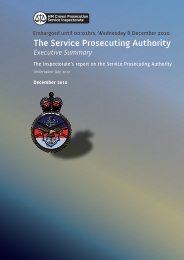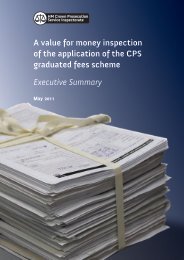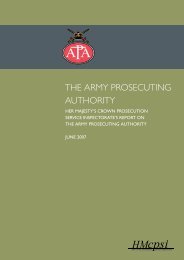Actions speak louder: A second review of healthcare in ... - HMCPSI
Actions speak louder: A second review of healthcare in ... - HMCPSI
Actions speak louder: A second review of healthcare in ... - HMCPSI
You also want an ePaper? Increase the reach of your titles
YUMPU automatically turns print PDFs into web optimized ePapers that Google loves.
FINDINGS<br />
ACTIONS SPEAK LOUDER<br />
Good practice from <strong>in</strong>spection reports<br />
“A young Muslim girl, who was referred for a health <strong>review</strong> to the<br />
youth <strong>of</strong>fend<strong>in</strong>g service nurse, disclosed hav<strong>in</strong>g unprotected sexual<br />
<strong>in</strong>tercourse. Good, sensitive, effective and coord<strong>in</strong>ated work took<br />
place between the nurse, social worker and the young person <strong>in</strong><br />
<strong>in</strong>vestigat<strong>in</strong>g the background to this issue while protect<strong>in</strong>g and<br />
support<strong>in</strong>g the young girl.”<br />
“The health workers aimed to provide a service that addressed<br />
<strong>in</strong>dividual and diverse needs. They were active <strong>in</strong> support<strong>in</strong>g young<br />
women with appropriate sexual health advice, and were <strong>in</strong>volved <strong>in</strong> the<br />
sexual exploitation strategic group, l<strong>in</strong>k<strong>in</strong>g with the local safeguard<strong>in</strong>g<br />
children board.”<br />
“There was proactive identification <strong>of</strong> general health needs and good<br />
liaison with GPs and general paediatrics, with access to a specialist<br />
black and m<strong>in</strong>ority ethnic worker, needle exchange and smok<strong>in</strong>g<br />
cessation services.”<br />
A total <strong>of</strong> 61% <strong>of</strong> children and young people whose cases were <strong>review</strong>ed by<br />
health <strong>in</strong>spectors were <strong>in</strong> full-time education and 35% were unemployed or ‘other’<br />
(figure 2). Clearly there is a significant issue here <strong>in</strong> terms <strong>of</strong> economic wellbe<strong>in</strong>g<br />
for those children and young people who have <strong>of</strong>fended or who are likely to, which<br />
needs to be more fully addressed. 6<br />
Figure 2: Sample <strong>of</strong> cases <strong>review</strong>ed by health <strong>in</strong>spectors (by occupation)<br />
35%<br />
4%<br />
61%<br />
Full-time education/tra<strong>in</strong><strong>in</strong>g<br />
Employed<br />
Unemployed or other<br />
Note: Figures for the wider sample <strong>of</strong> cases showed 58% <strong>in</strong> full-time education<br />
or tra<strong>in</strong><strong>in</strong>g with 6% <strong>in</strong> employment and 27% unemployed or ‘other’. The rema<strong>in</strong><strong>in</strong>g<br />
percentage relates to part-time education or tra<strong>in</strong><strong>in</strong>g. The number <strong>of</strong> cases<br />
<strong>review</strong>ed by health <strong>in</strong>spectors used <strong>in</strong> this analysis numbered 189.<br />
6<br />
This will be analysed further <strong>in</strong> a report on phase 4 <strong>in</strong>spections by Ofsted and HMI Probation, expected <strong>in</strong><br />
early 2009.<br />
13








